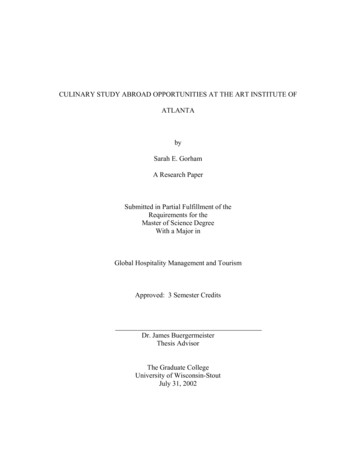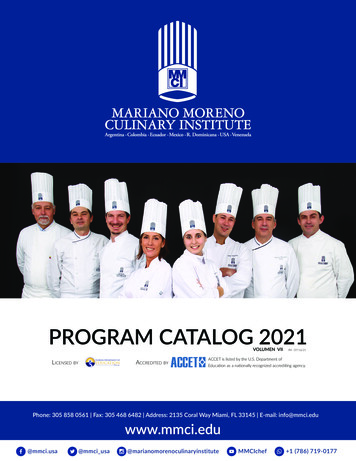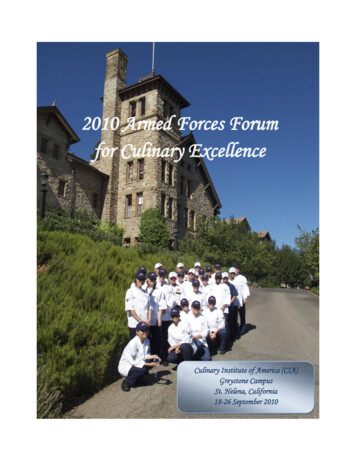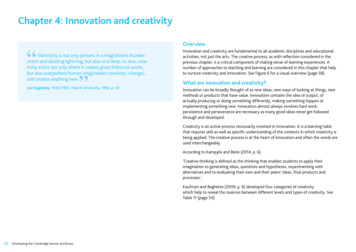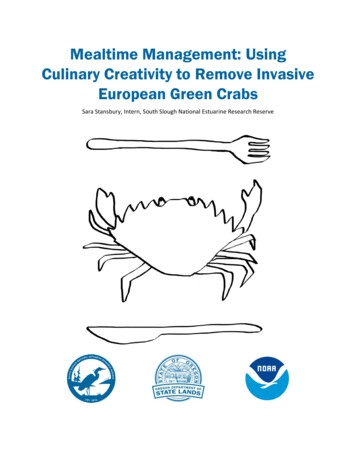
Transcription
0Mealtime Management: UsingCulinary Creativity to Remove InvasiveEuropean Green CrabsSara Stansbury, Intern, South Slough National Estuarine Research Reserve
1Table of ContentsForeword . 1Background on the European Green Crab . 2Preparing Green Crabs for Cooking . 4Recipes. 4Composting Inedible Parts . 14References Cited . 15
1ForewordInvasive European green crabs have established themselves as a problematic presence inOregon’s Coos Bay. Green crabs threaten native species and ecosystems through predation,competition, and habitat destruction. As our climate continues to change and the ocean warms,the number of green crabs is expected to increase, creating a need for coastal communities towork together to manage the population size and impacts of this invasive species.Coastal residents, businesses, and other entities can all help pitch in to reduce the numbers ofgreen crabs along the Oregon Coast and Coos Bay area. In many other parts of the world,including the American East Coast and Europe, people enjoy cooking with and eating greencrabs. This has led to demand and created industries. For example, the establishment of afishery for a close relative of the green crab in Venice has been a success (Walter, 2021). Theadoption of similar efforts in Coos Bay may allow our community to come together to enjoynew dishes, connect with the natural world, and protect our local environment in the process.In this guide you will find resources to help guide you on your adventure of cooking with greencrabs. We have included a brief background on green crabs and the history of theirestablishment along the Oregon Coast, helpful information on preparing green crabs forconsumption, and example recipes to kickstart your excitement and creativity. We’ve alsoincluded an informative flyer to alert the community about the presence of European greencrabs, and we encourage you to share this information with others.Thank you for your effort in taking on this challenge. It takes the work of passionate communityvolunteers to protect our local fisheries and beautiful environment, and your contribution tothis effort is making a real difference. We appreciate your support and partnership as togetherwe work to manage green crabs on Oregon’s coast. We hope you have fun cooking and creatingyour own recipes.
2Background on the European Green CrabOriginally from the Atlantic waters of Europe and Northern Africa, the European green crab is aspecies specially equipped to be able to establish in many different types of environments.Green crabs have been known to consume well over 100 different classifications of plants andanimals, so wherever they go, food supply is not an issue (Cohen et al., 1995). Additionally, theycan tolerate a wide range of temperatures and salinities (at least for a short time), helping themto survive in a variety of regions (Yamada, 2001).1Identifying European Green CrabsThough the name “European green crab”implies that color alone can be used toidentify these invaders, this is not the bestindicator for identification. In fact, dependingon their age, the European green crab canhave green, yellow, and even orange coloring.Instead, the telltale sign of a green crab is the5 spines (pointy triangles) on either side of thecrab’s eyestalks. Counting these spines canhelp distinguish green crabs from juvenileDungeness crabs, which may also be green.Males and females can be differentiated by looking at the underside of the crab. Male crabshave a thin, triangular apron, while females have a rounder and wider apron. Sometimesfemales will also be carrying eggs in their brood pouch; the presence of bright orange eggs canalso be used to identify a female green crab.1Image source: https://www.greencrab.org/learn
3MaleFemaleFemale with eggs – open apronFemale with eggs – closed apronThe European green crab was first discovered on the North American West Coast in the late1980’s, observed in San Francisco. Since this introduction, green crabs have traveled up thecoast and can now be found along the coasts of California, Oregon, Washington, and BritishColumbia. Recent research has indicated that warmer ocean temperatures may bestrengthening currents that help green crab larvae travel farther north (Yamada et al., 2021). Asgreen crabs disrupt the native food web, compete with—and eat—native crab species, anduproot plants like eelgrass that serve as important habitat, there is a clear need to manage thenumbers of this invasive species.Researchers along the Oregon Coast are working hard to monitor the abundance and spread ofthis green crabs. South Slough National Estuarine Research Reserve conducts yearly samplingefforts in Coos Bay to track the number of green crabs, where they are distributed, and the age
4class of these predators. Through efforts like these and the help of the local community there ishope that we can battle the green crab invasion, maintain the health of our native fisheries, andprotect the environment that helps make Coos Bay so beautiful.Catching European Green CrabsAlways follow Oregon Department of Fish and Wildlife guidelines and obtain a shellfish licensebefore crabbing. Additionally, call the Oregon Shellfish Biotoxin Hotline,1-800-448-2474 tocheck toxicity levels.Preparing Green Crabs for CookingOnce caught, European Green Crabs can be eaten as a delicious meal. The following pagesinclude a guide to green crab preparation and recipes generously created and shared byGabriela Bradt and the New Hampshire Sea Grant and University of New HampshireCooperative Extension. Please note: it is always recommended that you discard the crabinnards (viscera), including the mustard, before cooking, to avoid consuming harmful domoicacid.RecipesChefs and home cooks have developed an affinity for using green crabs for flavor and protein intheir dishes. We have included recipes for cooking green crabs in dishes, including a green crabrisotto recipe by The Other Cape and several created and compiled by Gabriela Bradt and theNew Hampshire Sea Grant and University of New Hampshire Cooperative Extension22Image provided by Tanya L. Rogers, https://outsidethequadrat.weebly.com/clipart.html
How to prepare Soft-Shell Green Crabs(Protocol adapted and printed with permissionfrom our partner Green Crab Cafe)ÓCleaning and preparing live soft-shell green crabs for consumption is quick and simple!1. Wash the crabs in cold water to remove any sand or mud.2. With scissors, trim off just enough of the face (a) (includes the spines between the eyes, eyestalks, antennae, and antennules). Trim off the ends (pointy parts) of the 4 pairs of the legs (b).Dorsal view: trim off the marked area with scissors(face, pointy ends of the legs).ab3. Flip the crab over and trim the apron (the V-shaped flap)(c) that opens up on the stomachand mouth parts (d).Ventral view: trim off the marked area with scissors(apron, mouth parts, pointy ends of the legs).c4. Gently lift each side of the carapace (top of the crab)and trim off the gills (e).LIFTd5. Finally, rub a little salton the crabs, rinse withcold water, and placethem in a strainer to beused.LIFTeAll photographs courtesy of Thanh Thai & Green Crab Cafe.NH Sea Grant is based at the University of New Hampshire as part of theNational Sea Grant College Program, which is administered by the NationalOceanic and Atmospheric Administration (NOAA). seagrant.unh.edu
How to prepare Hard-Shell Green Crabs(Protocol adapted and printed with permissionfrom our partner Green Crab Cafe)ÓCleaning and preparing live hard-shell green crabs for consumption is a bit moretime-consuming than it is for soft-shell crabs1. Wash crabs in cold water to remove any sand or mud.2. Remove carapace using your fingers (a). You need to apply pressure when removing thecarapace because it is hard and the crabs are fast! With your thumb under one side of thecarapace, lift up while holding onto the belly with your other thumb and push down.Separate the carapace from the rest of the body (b).3. With your fingers or scissors, remove the mouth parts from the body, these are small, bonyprotrusions and remove the gills from either side of the body (the feathery looking tissue) (c).abc4. Break or cut off the distal tips of the legs and discard (d).5. With scissors or a knife, lift up the apron (V-shaped flap on the abdomen) and pull off (e).6. With a knife, remove the yellow/orange colored roe or ‘crab mustard’ from the middle of thebody (f) and from the inside of the carapace and save.deOptional: You can clean the prepared crabs with a salt rub (2 tsp-1 Tbsp).Rinse with cold water several times to remove the salt. You can also usevinegar (2-3 Tbsp) to wash, then rinse with cold water immediately. Do notlet the crabs soak in salt or vinegar as it will change their taste and texture.All photographs courtesy of Thanh Thai & Green Crab Cafe.NH Sea Grant is based at the University of New Hampshire as part of theNational Sea Grant College Program, which is administered by the NationalOceanic and Atmospheric Administration (NOAA). seagrant.unh.eduf
How to Pick Meat, Roe and Crab Mustardfrom Cooked Green CrabsÓ(Protocol adapted and printed withpermission from our partner Green Crab Cafe)Picking cooked green crabs for meat, roe and crab mustard is certainly more time-consumingbut it is worth it for the sweet flavor!1. Clean live crabs well in cold water. Boil crabs in water for 5-7 minutes. Crabs will turn redwhen cooked. Let cool.2. Remove carapace (top shell) from cooled crabs (a).3. Scoop the roe and crab mustard (yellow-orange material) from the carapace (b). Keep roeand mustard if desired. Discard the carapace.4. Gently pull the apron ( V-shaped flap on abdomen) to remove the intestine and discard (c).bacc5. Remove the roe from the body, if any, and save (d).6. Use a knife to cut the body into 4 sections (e). Remove the meat between the cartilage andsave (f). Discard the gills, cartilage, shell bits and any non-edible parts.def8. Use a nut/lobster cracker to gently crack or break the shell of the claw and remove the meat(g). Remove and discard the cartilage located inside the middle of the claw.9. Look through the meat, remove and discard any shell or cartilage.gNH Sea Grant is based at the University of New Hampshire as part of theNational Sea Grant College Program, which is administered by the NationalOceanic and Atmospheric Administration (NOAA). seagrant.unh.eduAll photographs courtesy ofThanh Thai & Green Crab Cafe.
GREEN CRAB & MONKFISH CEVICHEby Thanh ThaiBlogger, Green Crab CafeIngredientsGreen Crab roe1/2 lb of diced monkfish10-12 thin slices-red onionFresh lime juice-to taste1 tsp chopped chili peppers(optional)Directions1 tsp chopped cilantro leaves1 tsp chopped scallion(green parts only)Salt, to tasteA generous pinch each-limeand lemon zest P R E P A R A T I O N :20MINCOOKING: 25 MINREADY IN: 30-35 MINSimmer the green crabs (use the amount depending on how muchroe there is and your preference) for about 10 minutes. Drain andcool completely.Remove roe and save.Steam and dice monkfish until just cooked (if you can easilypierce with a fork-then it is done).Thinly slice red onion and soak in cold water, squeeze out waterbefore using.Combine all ingredients in a bowl and gently mix.
GREEN CRAB FRIED RICEby Julie Upham4th Grade Teacher, West Bath SchoolIngredientsGreen crab stock – amount neededto cook rice (may vary)3 cups cooked rice2-3 tablespoons vegetable oil6 cloves chopped garlic2 eggs, beaten3 tablespoons fish sauce4-6 chopped green onionSalt and pepper to tastePREPARATION: 10 MINCOOKING: 20 MINREADY IN: 30 MINDirectionsCook the rice according to package instructions, substituting greencrab stock for the water.Heat oil in large skillet, sauté garlic 1-2 minutes.Pour beaten eggs into pan and scramble using spatula.Add cooked rice and fish sauce to skillet, stir well, season to taste.Add chopped green onions, stir, and serve immediately
GREEN CRAB STOCKby Julie Upham4th Grade Teacher, West Bath SchoolIngredientsMakes 6 quarts4 tablespoons olive oil2 bunches celery, with the leaves, about 1pound, roughly chopped1 large red onion, roughly chopped1 small head fennel, cut into 1/2” slices12 corn cobs (optional)PREPARATION: 20 MINCOOKING: 1 HOURREADY IN: 1 HOUR 20 MINSalt2 bay leaves1 tablespoon Old Bay seasoningApproximately 3 quarts water2 cups white wine2 dozen green crabsDirectionsRinse crabs well in cold water. I recommend doing this outside in a large bucket; just fill thebucket with water and throw your crabs in. Stir well, and leave them in the bucket until yourstock is boiling.In a large stock pot or lobster pot heat the olive oil to medium. Add the celery, onion, andfennel. Lower heat, and cook until vegetables are soft, about 15 minutes. Add the corn cobs ifusing, the salt, bay leaves and Old Bay and stir well, tossing the vegetables well with theseasoning. Allow to cook for 5 more minutes, or until the onions just begin to darken.Add the water and wine, and bring to a boil. Let simmer for 10-15 minutes tointegrate theflavors, particularly the corn cobs.4. Bring stock back to a hard boil. Bring the crabs into the kitchen, and scoop them into theboiling stock. Allow to cook at a strong simmer/low boil for 45 minutes. Let cool, and spoonout the cooked crabs and as much of the vegetables as you can. Strain the remaining cooledbroth through cheesecloth. Pour into jars or plastic containers for storing or freezing.
GREEN CRAB POZOLEby Matt LouisChef/Owner Moxy and Franklin Oyster House, Portsmouth, NHIngredients1 small onion, diced1 yellow and 1 red bellpepper, diced4 oz hominy1 ½ qts green crab stock½ tbs cumin½ tbs smoked paprikaSalt and pepper to taste½ bushel cilantro3 red radishes, shaved4 oz Napa cabbage,shreddedDirectionsSweat onions and peppersover medium heat with alittle canola oil until soft.Add hominy and spicesand toast gently.Add green crab broth andseason to taste.Split between bowls andgarnish with cilantro,radish, and cabbage.PREPARATION: 10 MINCOOKING: 10 MINREADY IN: 20 MIN
GREEN CRAB RAMEN SOUPby Jenny DevivoWest Tisbury School, Martha's VineyardThe Broth2 lbs cleaned green crab bodies,unpickedApproximately 4 1/2 cups water1 onion, roughly chopped2 celery stalks, roughly chopped2 carrots, roughly chopped3 garlic cloves, smashedSalt & PepperThe Ramen1 tsp sesame oil1 tsp vegetable oil3 tsps grated ginger4 tsps grated garlic1/2 tsp Chinese All Spice Powder4 cups green crab broth1 cup of water2 packages dried ramen noodles1/2 cup chopped scallions1/2 cup shredded carrots1/2 cup thinly sliced red peppers1/2 cup shredded kale1 cup extra firm tofu, diced1 Lime, cut into wedges1/4 cup chopped cilantroDirectionsPlace the crabs, onion, celery, carrots & garlicinto a large stockpot. Fill pot with cold wateruntil all ingredients are covered. Bring to aboil, add a little salt & pepper then reducebroth to a simmer for 1 to 2 hours.Carefully pour the broth through a meshstrainer into a large bowl & set aside.Heat the oils in a large skillet over mediumlow heat. Add the garlic and ginger; stir fry for2 minutes until soft and fragrant. Add thebroth and the water. Bring to a boil thensimmer for 10 minutes. Add the Chinese AllSpice Powder, tofu & instant noodles to thebroth and simmer for an additional 5 minutesor until the noodles have softened. Removefrom heat, stir in the scallions, carrots, redpeppers & kale. Add a squeeze of fresh limejuice & sprinkle w/ cilantro.PREPARATION: 30 MINCOOKING: 1-2 HOURSREADY IN: 1-2.5 HOURS
13Earth Week Green Crab RisottoBy Heather Atwood[serves 6]Ingredients: 6 cups green crab stock 1 T butter 1 T olive oil 1/2 red onion, chopped 3 small carrots, diced, about 4 ounces 1 small banana pepper, or 1/2 a green pepper, seeded and diced 1 small red hot pepper, 1/2 ounce, diced (optional) 1 1/2 cups or 12 ounces Arborio rice red pepper flakes salt and pepper 3 small tomatoes, seeded and chopped 1 pound crab meat (1/2 - 3/4 cup reserved for garnish if you like) juice from 1-2 lemons or to taste 1/2 cup toasted slivered almonds 1/2 cup chopped fresh dillPreparation:1. In a medium sauce pan bring the stock to a simmer.2. In a large sauté pan heat butter and olive oil together on medium heat. When butter ismelted and bubbling, add onion, carrots, and peppers. Let cook for 8-10 minutes overmedium heat until softened.3. Add rice, and stir well, cooking until the rice begins to crackle and just begin to turnlightly brown. Season with salt, pepper, and red pepper flakes.4. Ladle in 1 cup of the hot broth into the rice. Stir until it is all absorbed. Add the choppedtomato, and then ladle in another cup of stock. Stir until the stock is absorbed, and thencontinue to ladle in the stock, stirring each addition until it is absorbed. This usuallytakes 20-25 minutes.
145. Taste the rice to make sure there is no “crunchiness” to it at all. You want it to becreamy, but not mushy. Stir in the fresh lemon juice. Serve in warm bowls garnishedwith the reserved crab, toasted almonds, and chopped dill.Composting Inedible PartsWhile most parts of the green crab can be used in recipes, it is possible that after cooking youmay be left with some waste, especially if working with hard-shell crabs. Green crabs can becomposted to enhance soil using the following steps:1. Boil the inedible parts for 5 minutes to decrease their smell and help keep animalsaway.2. Put the boiled parts into your compost bin with some soil and worms.3. Turn the compost monthly to help it decompose.
15References CitedBradt, Gabriela. NH Sea Grant & UNH Cooperative Extension. NH Green Crab Project Resources:Market Development, Harvesting, and Culinary Use Guides. seagrant.unh.edu/nh-greencrab-project.Cohen, A.N., J.T. Carlton, and M.C. Fountain. 1995. Introduction, dispersal and potential impactsof the green crab Carcinus maenas in San Francisco Bay, California. Marine Biology122:225–37.Walter, William. 2021. Green Economics: Assessing the Feasibility of a New England Green Crab(Carcinus maenas) Fishery through Fishermen Perspectives. Graduate Program in OceanFoods Systems, University of New England, Maine, USA.Yamada, S. B. (2001). Global invader: The European Green Crab. Oregon Sea Grant, OregonState University.Yamada, S. B., Gillespie, G. E., Thomson, R. E., & Norgard, T. C. (2021). Ocean indicators predictrange expansion of an introduced species: Invasion history of the European Green CrabCarcinus maenas on the North American Pacific Coast. Journal of Shellfish Research,40(2). https://doi.org/10.2983/035.040.0212
Chefs and home cooks have developed an affinity for using green crabs for flavor and protein in . Cleaning and preparing live soft-shell green crabs for consumption is quick and simple! LIFT LIFT . let the crabs soak in salt or vinegar as it will change their taste and texture. All


